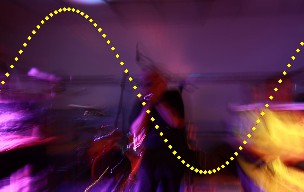Eine deutsche Version dieser Webseite gibt es hier.
The video shows an oscillating blues harmonica reed, recorded with a high-speed camera. The camera generates 9000 frames per second (9000 frames per second = 9000fps). For a complete oscillation 34 frames are needed in this video. So in one second the reed oscillates 9000:34 = 265 times. This corresponds to a tone of 265Hz (Hertz), i.e. a blow note on the first channel of a C-Harp. (A great thank you to the TNW PoF Lab (D. Lohse) of the Universiteit Twente for the permission to use their filming equipment and publish the footage on my website.)
If you gradually bend a draw note down, the blow reed in the channel vibrates more and more as well. You can convince yourself by unscrewing the cover plates. You can watch the reed vibrations or feel them with your finger.
Optical distance sensors can be used to translate the reed movements into electrical voltage fluctuations. One can then directly hear how the reeds move. The video shows a wavedata for a drawbend recorded with such a pickup. At first mainly the draw reed oscillates (red, right audio channel), at the end almost only the blow reed oscillates (blue, left channel). (Recording with an ELX by James Antaki, evaluation with Open Source Audacity.)
The lungs generate a constant flow of breath. How can an air stream flowing exclusively in one direction cause the blues harp reed to swing back and forth 265 times per second in the high-speed video? What makes the blow reed cooperate with the draw reed, which is actually responsible for draw notes, during a drawbend? These are typical physics questions. Even if you don't always and not immediately know the answer, it's fun to deal with such questions.
- An offer to get started is the website FAQ with questions and answers about the physics of the blues harmonica.
- The page Fascination of the Physics of the Bluesharp gives a first overview.
- The page Frequencies deals with which notes are playable on the blues harp and how the two reeds cooperate in the channel.
- The page Literature gives a brief overview of literature on the blues harp and the physics of the blues harp.
In addition to these popular science web pages, I have written a number of scientific essays in recent years, which are offered as pdf files on the Essays page.
My talk on the physics of the blues harp at the annual conference DAGA 2023 of the German Acoustic Society is published in the conference proceedings and can be downloaded here.
NEW At the DAGA 2024 in Hanover, I gave a lecture on "Cooperative behavior of both reeds in the channel of a blues harmonica when bending", which has meanwhile been published in the conference proceedings: Link
